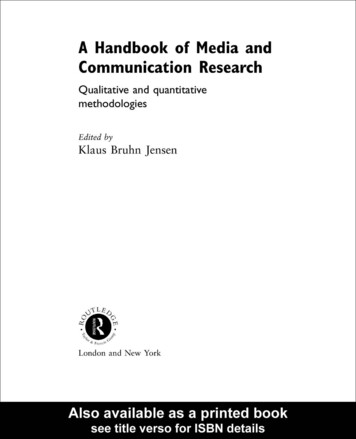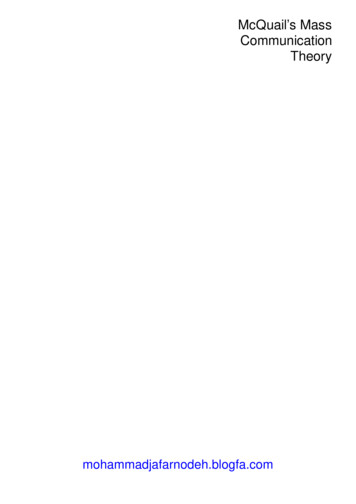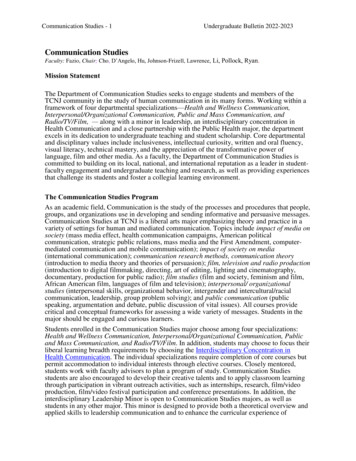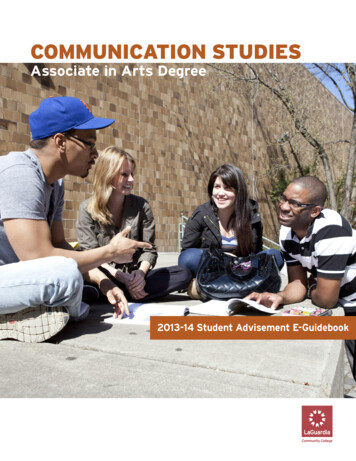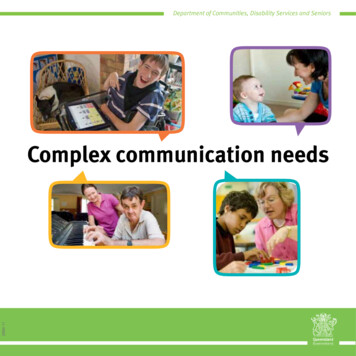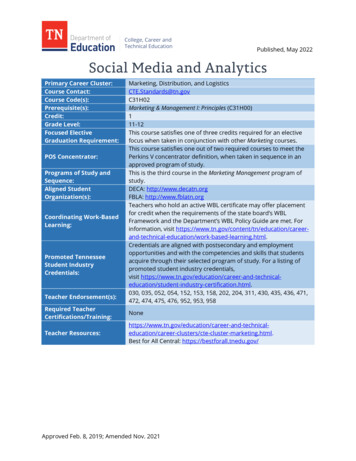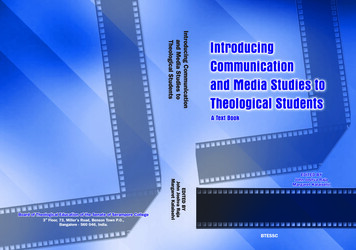
Transcription
iINTRODUCINGCOMMUNICATION AND MEDIASTUDIES TO THEOLOGICALSTUDENTSA Text BookEdited byJohn Joshva RajaMargaret KalaiselviBTESSC
iiIntroducing Communication and Media Studies to Theological StudentsINTRODUCING COMMUNICATION AND MEDIASTUDIES TO THEOLOGICAL STUDENTSA Text Book 2006, 2008, 2013, BTESSCRevised Edition - 2013ISBN: 978-93-83002-01-6Published byBTESSC3rd Floor, 73, Miller’s RoadBenson Town P.O.,Bangalore - 560 046, India.Tel: 23536868, Fax: 23538274E-mail: secretary@btessc.orgTypeset and Printed atNational Printing PressKoramangala, Bangalore-95Phone: 25710658
iiiThis book is dedicated toFr Dr Michael Traber,Rev Dr A D Manuel, Rev T Appavoo(Parattai) and Rev Dr C R W Davidfor their contribution to the field ofChristian Communication
ivIntroducing Communication and Media Studies to Theological Students
Introducing Communication and Media Studies toTheological StudentsvA Text BookCONTENTSPublisher’s NotexixAcknowledgementsxxiIntroductionChapter 1:Understanding Communication Processxxiii11. Defining ‘Communication’12. Communication as a Dialogue43. Communication as a process54. Communication as an On-going Process7Chapter 2:Types of Communication1. Intra-personal Communication1010a. Characteristics of intra-personal communication11b. Significance of Communication12c. Intra-personal Activities13d. Models of Intra-personal Communication14e. Intra-personal Communication in Christian Life142. Inter-personal Communication15a. Characteristics of Inter-personal Communication16b. Functions of Inter-personal Communication17c. Stages of Inter-personal Communication18d. Developing Skills in Inter-personal Communication18e. Inter-personal Communication in biblical narratives19f. Advantages of Interpersonal communicative skills193. Group Communication20a. Categories or types of Groups21b. Stages of Group Development23
viIntroducing Communication and Media Studies to Theological Studentsc. Media of Group Communication23d. Leadership24e. Group Leadership: Its Theory and Function264. Mass Communication27a. The concept of ‘Mass’28b. Mass product28c. Mass audience29d. Mass Culture295. Public Communication296. Folk Communication32Chapter 3:35Humans – The Animals that Speak1. Types of Languages372. Audio/Verbal Languages383. Script, the Visual Codification of Verbal Language394. Visual Languages415. Body Language (non-verbal)416. Audio-Visual Language44Chapter 4:46Communicative Preaching1. Definitions462. Elements of Preaching473. Role of Hermeneutics in Preaching484. Different Kinds of Preaching495. Steps involved in Preaching506. Levels of communications517. Feedback52Chapter 5: Models of Communication1. Berlo’s SMCR Model2. Lasswell’s Linear Model5454553. Shannon and Weaver’s Noise Model57
vii4. Osgood and Schramm’s Circular Model585. Gerbner’s Model596. Maletzke’s Model of the Mass Media627. Newcomb’s ABX Model638. Westley and Maclean’s Model639. Dance’s Helical Model64Chapter 6:66Barriers to Communication1. Mechanical Barriers662. Physical Barriers663. Linguistic Barriers674. Psychological Barriers675. Environmental Barriers68Chapter 7:Humans are Compulsive Story Tellers691. The Public Story Tellers, the Professional Narrators712. The Social Context of the Narrative72a. Institutional control72b. Ideology73c. Gender733. Narrative Model734. Types of Stories74a. Autobiographic stories74b. Foundational stories75c. Oppositional and counter stories75d. Parables76Chapter 8:Communication and Society771. Communication as Symbolic Process782. Models of interaction793. Issues in interaction80
viiiIntroducing Communication and Media Studies to Theological Students4. Social scientific analysis of interaction815. Doing a Communication Research83(a) Psychological Experiments85(b) Cultural analysis86(c) Content analysis87Chapter 9:Mass Communication and Culture881. What is Culture?882. Culture and Mass Media Theories91Critical Cultural/Communication Theory91a. Ideology92b. Commodity93c. Consciousness94d. The ‘trade’ school96e. Mass Media and ‘Popular Culture’973. Metaphors of Media’s Role in Society98Chapter 10: History of Mass Media991. Cave painting992. Age of Orality100(a) Social System101(b) Narrativity101(c) Theocratic rule and authority of the elder101(d) Oracle101(e) Religion holds the power1013. Invention of writing1024. Print Media1025. Book1036. Newspaper1047. Telegraph105
ix8. Electronic media1069. Types of Media106a. Radio106b. Televisionc. Cinema108110d. Computer112e. Internet113f. Patterns of Internet115Chapter 11: History of Christian Media and Missionbetween 1910 and 20101171. Perspectives on Media between 1910-20101212. Print Media - Extended hands of Evangelization1263. Audio - Cassette - Mouthpiece of Mission1274. Radio - the Megaphone of Evangelism1295. Film and Television - Clouds of Witness1326. Television1347. Ecumenical Institution for Media and Mission1358. Internet and new media - Heart of Christian Mission137Chapter 12: Communication, Religion and Theology1391. Mass Media and Mass Religion139a. Mediated Religion140b. Media’s attitude towards religion146c. Religion and Media representation147d. Religious attitude towards Media150e. Media’s influence on Religion151f. Researches in this area1522. Theology and Communication154a. Church and Communication156b. Christian Communication158
xIntroducing Communication and Media Studies to Theological Studentsc. Medium shapes the message of faith160d. A Christian view of Communication162Chapter 13: Christian Themes in Films176Section A : Imagining Jesus in movies176Introduction1761. The Passion of the Christ1782. The Da Vinci code1793. Subversive meanings1804. Drama of gods1815. Da Vinci Code : Responses1846. The Passion of Christ1857. Hollywood’s presentations1868. Imagination, media and theology1879. God and imagination189Section B : Bible and Imagination : Selected examples1911. Imagining God through Bibilical Narratives1912. Dialogue within God1933. Jung and the ‘opposites within God’1944. God and the many voices1955. Dialogue and the Word1976. Dialogue within Jesus197Conclusion199Chapter 14: Communication and Ministry2011. Present Models201a. SMCR Model202b. EID Model203c. PSI Model2052. Communication and Ministry2063. Culture of Communication208
xia. Mediated Communication208b. Powerful communication210c. Divided Communication2114. Ministerial Communication2135. Communication Ministry2146. Alternative Ministry216Chapter 15: Communication and Mission2181. Understanding Mission from the Communication Perspective 218a. Transmission Model of Mission219b. Circular Model of Mission223c. Ritual model of Mission2252. Tension in Mission2273. Plurality of Mission2284. Seven ( 1) ways of doing Mission2295. Mission in its context2316. Mission and Praxis2387. The Great Commission to us240Chapter 16: Alternative media and Mission2421. Alternative Media243a. Brief background of the Alternative243b. What is Alternative media?2452. Communications and Media in the Church2483. Alternative Media and Mission249a. Sharing the Gospel249b. Serving Christian Community250c. New Spirituality, Alternative media and mission252d. Interacting with Communities254e. Alternative Media for Development256f. Net as Alternative Media256
xiiIntroducing Communication and Media Studies to Theological Studentsg. Training Priests and Missionaries257h. Banking the Knowledge257i. Alternative - Media Education as mission258j. Alternative media and cultural groups2594. Alternative Media for Harmony and Reconciliation260a. Why do we need alternative media?261b. Mass Media and Culture of Suspicion264c. Harmony and Reconciliation265d. Alternative Media and Harmony266e. An Example of the Alternative Media inpromoting Harmony and Reconciliation270Chapter 17: Internet, Mission and Ecumenism271Introduction271a. Net and Action271b. Net and Dialogue2711. Media, Mission and Ecumenism272a. Instrumental Use272b. Effect-Centred Perspective273c. Jesus’ Communication2742. Internet Scenario in India275a. Internet Availability275b. Net and Reality276c. Church Net277d. Netizens and Missionary Organisations278e. Christian Institutions278f. Yahoo groups2793. Grasping the technology and culture of the Net280a. High Speed and exchange of information281b. Interactive Net282
xiiic. Convergence and hypertext282d. Digital world and Virtual Self283e. God and I in the Net284f. The Other side of the Web2844. Internet and Mission – Possibilities285a. Sharing the Gospel285b. Interactive Communities286c. Serving Christian Community287d. Training Pastors and Missionaries288e. Ecumenical Net289f. Networking different Communities290g. Banking the Knowledge291h. Preserving traditions and culture291Conclusion292Chapter 18: Challenges from Television Guru294Section A : Tele-evamgelists and commercial gospels294Introduction2941. Tele-gurus and the media market2972. Mediated theologies2993. Mediatised theologies3014. Popular theologies3025. Cheap grace3026. Sensational theologies3047. Commercial theologies3058. Fundamentalist theologies307Section B : A Theological reflection on Fundamentalisttheologies3081. No other name?3082. Critique of exclusive approaches310
xivIntroducing Communication and Media Studies to Theological Students3. Narrative idols3114. Hidden Christ?3125. Critique of inclusive approach3146. Anonymous Christianity3147. Many names3158. Critique of pluralism3169. Narrative and experience31710. Taking the audience seriously in doing theology31911. Engaging with the ‘Other’ - theologozing in public32012. Theologians and tele-gurus321Section C : Facing Challenges of Telegurus3221. A need for media literacy and theological literacy3232. Media literacy as liberative praxis323Section D : Conscientization as part of Media literacy327Paulo Freire327A. Banging Versus Liberating327B. Action and Reflection328C. ‘Freire and Communication’329Section E : A Need for a theology of entertainment3301. Kiekegaard and Aesthetics334A. Aesthetic as Hermeneutic Starter335B. Aesthetic Hermeneutics and Choices3362. Parables and Hermeneutical Aesthetics337The Use of the Aesthetic Elements in the parables337i. Using Familiar Characters339ii. Using Contemporary Forms340iii. Using Familiar Scenes342iv. Haggadic, Aesthetic and the Parable of the Good Samaritan 3433. ‘Aesthetic Elements and the Parable of the Good Samaritan’344
xv4. Aesthetic Elements and Hermeneutics348Conclusion350Chapter 19: Dialogue as Communication3521. Modern Means of Communication3522. Existing Models of Inter-faith Communication3543. Inter-religious Dialogue3594. Four Margas3625. Modern Means of Communication andInter-religious Dialogue367a. Dialogue with media-people369b. Dialogue through the Media370c. Dialogue about the Media373d. Dialogue in the Media376e. Dialogue and the Media3795. Examples of Dialogue using the Modern Means ofCommunicationa. Television380380(i) Listening Project380(ii) Broadcast Model380b. Internet383(i) Inter-faith Interaction383(ii) Inter-faith Pals383(iii) The Inter-faith Internet Community Action Network385Conclusion386Chapter 20: Drama and Dance for AuthenticCommunication3881. Authentic Community3882. Dance and Drama3893. Bible and Dance389
xviIntroducing Communication and Media Studies to Theological Students4. Bhakti and Relationship3905. Theo-dramatik3906. Arts of Dialogue3907. Art of Critics3918. Communi-action3919. Imagination, Aesthetics and Visual Hermeneutics39210. Spect-actors39211. Dramatic Change12. Dancing for Change39239313. Breaking Dualism39314. Drama-activate39415. Authentic praxis394Chapter 21: Media and Global Issues3951. Globalization of Media: Problems and Challengesfor Theological Education395a. Background of Globalization of the Media397b. Globalization of the Media after NWCIO400c. Globalization of the media and people403d. Neo-Spirituality and Global media404e. Engaging with the Global Media406f. Challenges for Theological Education4082. Disparities in Global information412Chapter 22: Development, Communication and Ministry4191. Communication for Development in Indiaa. An Overview of Development Activities419421b. Communication for Development429(i) Communication Effects Approach329(ii) Diffusion of Innovation Approach330(iii) Mass Media and Modernization Approach330
xviic. Communication for Development in India435d. Our Role in the Communication forDevelopment in India Today439Conclusion4432. Convergence, Networking and Development443a. Utopian Perspective444b. Dystopian perspective445c. Third way?445d. ICT and development446e. Convergence449f. Convergence and applications450g. Convergence and development451h. Networking453i. what is networking?453j. Why networking is essential for us?454k. Web-cafe model455l. Web casting model456m. Multicasting model456n. Examples of the use of ICT for Development458End Notes459Bibliography475Unpublished Papers512Webliography516
xviiiIntroducing Communication and Media Studies to Theological Students
xixPublisher’s NoteOne of the few books which is always in heavy demand from variouscorners is the book titled ‘Introduction to Communications and MediaStudies to theological Students,’ originally edited by Dr. John JoshvaRaja and Dr. Samson Prabhakar. We are grateful to them. When wewanted to re-print this book again we approached Dr. John Joshva Rajaand he readily agreed to work with Dr. Margaret Kalaiselvi who was onher sabbatical in Queens College, Birmingham by adding some chaptersand do some editing of the old ones and changed the present article oncommunication development. This book is written with the view tohelp the theological students. They can use this as a text book. In theSenate curriculum, the focus of the branch was only on some definitionsand skills of communication, especially in relation to various forms ofcommunication of the gospel, such as preaching, teaching, public speechand some indigenous forms of telling the stories of the Bible. However,the book enlarges its perspective to include some articles which arebeyond the purview of the curriculum to give the students a wider view.“With the technological advancement, communication transformedfrom techniques to technology, from an area of study to a field of study,and from audio to video. Pictures and colors took prominence over wordsand sounds. Communication Technology, thus became a challenge notonly to education in general but theological education in particular byraising questions about effectiveness, ethics, values and so on. Printand electronic media, cell phone and internet, computers and robotsbrought about changes not only in the ways of communication but waysof life as well. Consequently, the subject matter to be studied in termsof communication could not be limited only how to communicate, butwhat and why to communicate also; thus raising questions that werenever asked before.”Considering the importance of the communication studies, theSenate of Serampore College/University has made it as a separate
xxIntroducing Communication and Media Studies to Theological Studentsdepartment and has attracted many students who are specializing now inthis field. We should remember people like Michael Traber, C.R.W. Davidand Theophilus Appavoo (Parattai) for their contribution to this field.BTESSC is happy to publish this book for the benefit of all thestudents who are doing their BD and other basic theological studies inIndia. The book would also be very useful for the teachers not onlyin theological colleges but also in the secular universities becausecommunication is a field that crosses boundaries in this regard. BTESSCis grateful to all who have contributed to the bringing out of this bookespecially to the editors Dr. John Joshva Raja and Dr. Margaret Kalaiselviand hopes that it would be used well by those who have responded tothe calling of communicating the good news in a world that is beingconfused and terrorized by various voices and noises.P. Mohan LarbeerSecretary, BTESSC
Chapter 9: Mass Communication and Culture 88 1. What is Culture? 88 2. Culture and Mass Media Theories 91 Critical Cultural/Communication Theory 91 a. Ideology 92 b. Commodity 93 c. Consciousness 94 d. The 'Trade' School 96 e. Mass Media and 'Popular Culture' 97 3. Metaphors of Media's Role in Society 98 Chapter 10: History of Mass .


